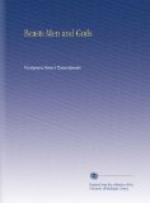To the north on a conical-shaped hill rose a tower that recalled the Babylonian zikkurat. It was the temple where the ancient books and manuscripts were kept and the broken ornaments and objects used in the religious ceremonies together with the robes of deceased Hutuktus preserved. A sheer cliff rose behind this museum, which it was impossible for one to climb. On the face of this were carved images of the Lamaite gods, scattered about without any special order. They were from one to two and a half metres high. At night the monks lighted lamps before them, so that one could see these images of the gods and goddesses from far away.
We entered the trading settlement. The streets were deserted and from the windows only women and children looked out. I stopped with a Russian firm whose other branches I had known throughout the country. Much to my astonishment they welcomed me as an acquaintance. It appeared that the Hutuktu of Narabanchi had sent word to all the monasteries that, whenever I should come, they must all render me aid, inasmuch as I had saved the Narabanchi Monastery and, by the clear signs of the divinations, I was an incarnate Buddha beloved of the Gods. This letter of this kindly disposed Hutuktu helped me very much—perhaps I should even say more, that it saved me from death. The hospitality of my hosts proved of great and much needed assistance to me because my injured leg had swelled and was aching severely. When I took off my boot, I found my foot all covered with blood and my old wound re-opened by the blow. A felcher was called to assist me with treatment and bandaging, so that I was able to walk again three days later.
I did not find Colonel Kazagrandi at Zain Shabi. After destroying the Chinese gamins who had killed the local Commandant, he had returned via Van Kure. The new Commandment handed me the letter of Kazagrandi, who very cordially asked me to visit him after I had rested in Zain. A Mongolian document was enclosed in the letter giving me the right to receive horses and carts from herd to herd by means of the “urga,” which I shall later describe and which opened for me an entirely new vista of Mongolian life and country that I should otherwise never have seen. The making of this journey of over two hundred miles was a very disagreeable task for me; but evidently Kazagrandi, whom I had never met, had serious reasons for wishing this meeting.
At one o’clock the day after my arrival I was visited by the local “Very God,” Gheghen Pandita Hutuktu. A more strange and extraordinary appearance of a god I could not imagine. He was a short, thin young man of twenty or twenty-two years with quick, nervous movements and with an expressive face lighted and dominated, like the countenances of all the Mongol gods, by large, frightened eyes. He was dressed in a blue silk Russian uniform with yellow epaulets with the sacred sign of Pandita Hutuktu, in blue silk trousers and high boots, all surmounted by a white Astrakhan cap with a yellow pointed top. At his girdle a revolver and sword were slung. I did not know quite what to think of this disguised god. He took a cup of tea from the host and began to talk with a mixture of Mongolian and Russian.




